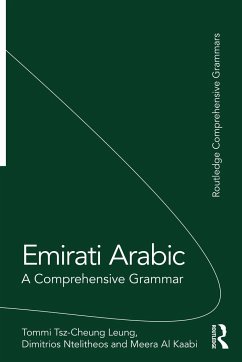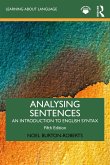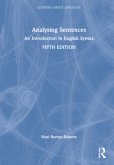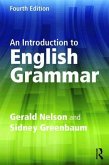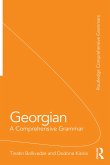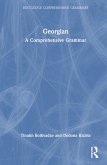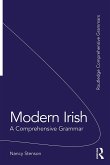- Broschiertes Buch
- Merkliste
- Auf die Merkliste
- Bewerten Bewerten
- Teilen
- Produkt teilen
- Produkterinnerung
- Produkterinnerung
Emirati Arabic: A Comprehensive Grammar offers readers a reference tool for discovering and studying in detail the specific dialect of Arabic spoken in the United Arab Emirates. It covers all major areas of Emirati Arabic grammar, describing in detail its phonological, morphological, syntactic, and semantic systems. Each grammatical point is illustrated with numerous examples drawn from native Emirati Arabic speakers and is thoroughly discussed providing both accessible and linguistically informed grammatical description.
This book is a useful reference for students of Gulf Arabic and/or…mehr
Andere Kunden interessierten sich auch für
![Emirati Arabic Emirati Arabic]() Tommi Tsz-Cheung LeungEmirati Arabic201,99 €
Tommi Tsz-Cheung LeungEmirati Arabic201,99 €![Analysing Sentences Analysing Sentences]() Noel Burton-RobertsAnalysing Sentences40,99 €
Noel Burton-RobertsAnalysing Sentences40,99 €![Analysing Sentences Analysing Sentences]() Noel Burton-RobertsAnalysing Sentences152,99 €
Noel Burton-RobertsAnalysing Sentences152,99 €![An Introduction to English Grammar An Introduction to English Grammar]() Gerald Nelson (China The Chinese University of Hong Kong)An Introduction to English Grammar46,99 €
Gerald Nelson (China The Chinese University of Hong Kong)An Introduction to English Grammar46,99 €![Georgian Georgian]() Tinatin BolkvadzeGeorgian70,99 €
Tinatin BolkvadzeGeorgian70,99 €![Georgian Georgian]() Tinatin BolkvadzeGeorgian158,99 €
Tinatin BolkvadzeGeorgian158,99 €![Modern Irish Modern Irish]() Nancy StensonModern Irish68,99 €
Nancy StensonModern Irish68,99 €-
-
-
Emirati Arabic: A Comprehensive Grammar offers readers a reference tool for discovering and studying in detail the specific dialect of Arabic spoken in the United Arab Emirates. It covers all major areas of Emirati Arabic grammar, describing in detail its phonological, morphological, syntactic, and semantic systems. Each grammatical point is illustrated with numerous examples drawn from native Emirati Arabic speakers and is thoroughly discussed providing both accessible and linguistically informed grammatical description.
This book is a useful reference for students of Gulf Arabic and/or Modern Standard Arabic or other Arabic dialects with an interest in the dialect spoken in the UAE, researchers interested in Arabic language and linguistics as well as graduate students and scholars interested in Arabic studies.
This book is a useful reference for students of Gulf Arabic and/or Modern Standard Arabic or other Arabic dialects with an interest in the dialect spoken in the UAE, researchers interested in Arabic language and linguistics as well as graduate students and scholars interested in Arabic studies.
Produktdetails
- Produktdetails
- Routledge Comprehensive Grammars
- Verlag: Routledge / Taylor & Francis
- Seitenzahl: 522
- Erscheinungstermin: 30. Dezember 2020
- Englisch
- Abmessung: 234mm x 156mm x 28mm
- Gewicht: 783g
- ISBN-13: 9780367220808
- ISBN-10: 0367220806
- Artikelnr.: 60039171
- Herstellerkennzeichnung
- Libri GmbH
- Europaallee 1
- 36244 Bad Hersfeld
- gpsr@libri.de
- Routledge Comprehensive Grammars
- Verlag: Routledge / Taylor & Francis
- Seitenzahl: 522
- Erscheinungstermin: 30. Dezember 2020
- Englisch
- Abmessung: 234mm x 156mm x 28mm
- Gewicht: 783g
- ISBN-13: 9780367220808
- ISBN-10: 0367220806
- Artikelnr.: 60039171
- Herstellerkennzeichnung
- Libri GmbH
- Europaallee 1
- 36244 Bad Hersfeld
- gpsr@libri.de
Tommi Tsz-Cheung Leung is Associate Professor in the Department of Cognitive Sciences at the United Arab Emirates University. His research specializes in syntax, phonology, typology, and psycholinguistics. Dimitrios Ntelitheos is Associate Professor in the Department of Cognitive Sciences at the United Arab Emirates University. His research interests include the investigation of morphological and syntactic structures from a theoretical perspective, as well as their cross-linguistic realization and their development in child language. Meera Al Kaabi is Assistant Professor and Chair in the Department of Cognitive Sciences at the United Arab Emirates University and a visiting academic at New York University Abu Dhabi. Her research interests include neurolinguistics, psycholinguistics, language disorders, morphology, and Semitic languages.
Table of Contents
Acknowledgments
List of Tables
List of Figures
List of Abbreviations
1 Introduction
1.1 Emirati Arabic
1.2 Triglossia in the UAE
1.3. The Descriptive Approach to Emirati Arabic
1.4 Transcription
1.5. Glossing
1.6. Abbreviations
Further Reading
2 Sounds of Emirati Arabic
2.1 Consonants
2.2 Vowels
Further Reading
3 Phonological Processes
3.1 Feature-Level Processes
3.2 Segment-Level Processes
3.3 Suprasegmental Processes and Phonotactics
Further Reading
4 Morphology and Word Formation
4.1 Non-Linear Morphological Processes
4.2 Affixation
4.3 Reduplication
4.4 Compounding
4.5 Loanwords
4.6 Acronyms, Abbreviations and Blending
4.7 Back Formation
4.8 Conversion
Further Reading
5 Syntactic Categories and Parts of Speech
5.1 Nouns
5.2 Verbs
5.3. Adjectives
5.4 Adverbs and Adverbial Expressions
5.5 Prepositions
5.6. Quantification: Numerals and Quantifiers
5.7 Complementizers
5.8 Pronouns
Further Reading
6 The Noun Phrase
6.1 Definiteness
6.2 Possession
6.3 Appositives
6.4 Nominal modifiers
6.5 Agreement in the Noun Phrase
6.6 Demonstratives
6.7 Word Order in the Noun Phrase
Further Reading
7 The Verb Phrase
7.1 The Copular Structure
7.2 State Verbs
7.3 Experiencer Verbs
7.4 Unergative Verbs
7.5 Unaccusative Verbs
7.6 Ditransitive Verbs
7.7 Existential and Possessive Predicates
7.8 Raising Predicates
7.9 Control Verbs
7.10 Reflexive Verbs
7.11 Complex Predicates
7.12 Causative Verbs
7.13 Passive Verbs
7.14 Complement-taking Verbs
Further Reading
8 Aspect
8.1 The Perfective Aspect
8.2 The Imperfective Aspect
8.3 Participles
8.4 Lexical Aspect
8.5 Grammatical Aspect
Further Reading
9 Mood and Modality
9.1 Deontic Modality
9.2 Epistemic Modality
9.3 Dynamic Modality
9.4 Modal Adverbs
9.5 Verbs Expressing Modality
9.6 Evidential Modality
9.7 Imperatives
9.8 Counterfactuals
9.9 Hortatives
9.10 Optatives
Further Reading
10 Negation
10.1 Verbal Negation
10.2 Non-Verbal Predicate Negation
10.3 The Negative Particle laa 'no'
10.4 The Negative Prefix - laa- 'not' and - eer- 'non-'
10.5 Negative Imperatives
10.6 Negative Coordination
10.7 Negation in Ellipsis
10.8 Negative Polarity Items
10.9 Negative Concord
Further reading
11 Word Order
11.1 Subject-Verb (SV) and Verb-Subject (VS)
11.2 Subject-Verb-Object (SVO)
11.3 Double Object Constructions
11.4 Word Order Permutation
Further reading
12 Relative Clauses
12.1 Restrictive Relative Clauses
12.2 Nonrestrictive Relative Clauses
12.3 Free Relative Clauses
12.4 Noun Complement Clauses
Further Reading
13 Questions
13.1 Yes-No Questions
13.2 Wh-Questions
13.3 Echo Questions
13.4 Embedded Questions
13.5 Rhetorical Questions
13.6 Exclamatives
Further Reading
14 Subordination
14.1 Temporal Clauses
14.2 Reason Clauses
14.3 Purpose Clauses
14.4 Conditional Clauses
14.5 Concessive Clauses
14.6 Other Subordinators
14.7 Parentheticals
Further Reading
15 Coordination
15.1 Conjunction w-/wa 'and'
15.2 Agreement in Coordination
15.3 Fixed Expressions Formed by w-/wa
15.4 Pragmatic Uses of w-/wa
15.5 Informal Use of w-/wa
15.6 bas 'but'
15.7 Disjunction wela 'or'
15.8 aw 'or'
15.9 fa- 'and then/so'
15.10 Contrastive Coordinator amma 'as for'
15.11 Comparative Coordinator an 'than'
15.12 Negative Coordinator mub 'not'
15.13 Correlatives in Coordination
15.14 Paratactic Coordination
Further Reading
16 Ellipsis
16.1 Gapping
16.2 Stripping
16.3 NP Ellipsis
16.4 VP Ellipsis
16.5 PP Ellipsis
16.6 Clausal Ellipsis
16.7 Comparative Deletion
16.8 Sluicing
Further Reading
17 Interjections
17.1 Primary Interjections
17.2 Borrowed Interjections
17.3 Secondary Interjections
Further Reading
18 Speech Conventions
18.1 Politeness
18.2 Terms of Address
18.3 General Honorific Terms
18.4 Trendy Language
Further Reading
Glossary of Terms
References
Index
Acknowledgments
List of Tables
List of Figures
List of Abbreviations
1 Introduction
1.1 Emirati Arabic
1.2 Triglossia in the UAE
1.3. The Descriptive Approach to Emirati Arabic
1.4 Transcription
1.5. Glossing
1.6. Abbreviations
Further Reading
2 Sounds of Emirati Arabic
2.1 Consonants
2.2 Vowels
Further Reading
3 Phonological Processes
3.1 Feature-Level Processes
3.2 Segment-Level Processes
3.3 Suprasegmental Processes and Phonotactics
Further Reading
4 Morphology and Word Formation
4.1 Non-Linear Morphological Processes
4.2 Affixation
4.3 Reduplication
4.4 Compounding
4.5 Loanwords
4.6 Acronyms, Abbreviations and Blending
4.7 Back Formation
4.8 Conversion
Further Reading
5 Syntactic Categories and Parts of Speech
5.1 Nouns
5.2 Verbs
5.3. Adjectives
5.4 Adverbs and Adverbial Expressions
5.5 Prepositions
5.6. Quantification: Numerals and Quantifiers
5.7 Complementizers
5.8 Pronouns
Further Reading
6 The Noun Phrase
6.1 Definiteness
6.2 Possession
6.3 Appositives
6.4 Nominal modifiers
6.5 Agreement in the Noun Phrase
6.6 Demonstratives
6.7 Word Order in the Noun Phrase
Further Reading
7 The Verb Phrase
7.1 The Copular Structure
7.2 State Verbs
7.3 Experiencer Verbs
7.4 Unergative Verbs
7.5 Unaccusative Verbs
7.6 Ditransitive Verbs
7.7 Existential and Possessive Predicates
7.8 Raising Predicates
7.9 Control Verbs
7.10 Reflexive Verbs
7.11 Complex Predicates
7.12 Causative Verbs
7.13 Passive Verbs
7.14 Complement-taking Verbs
Further Reading
8 Aspect
8.1 The Perfective Aspect
8.2 The Imperfective Aspect
8.3 Participles
8.4 Lexical Aspect
8.5 Grammatical Aspect
Further Reading
9 Mood and Modality
9.1 Deontic Modality
9.2 Epistemic Modality
9.3 Dynamic Modality
9.4 Modal Adverbs
9.5 Verbs Expressing Modality
9.6 Evidential Modality
9.7 Imperatives
9.8 Counterfactuals
9.9 Hortatives
9.10 Optatives
Further Reading
10 Negation
10.1 Verbal Negation
10.2 Non-Verbal Predicate Negation
10.3 The Negative Particle laa 'no'
10.4 The Negative Prefix - laa- 'not' and - eer- 'non-'
10.5 Negative Imperatives
10.6 Negative Coordination
10.7 Negation in Ellipsis
10.8 Negative Polarity Items
10.9 Negative Concord
Further reading
11 Word Order
11.1 Subject-Verb (SV) and Verb-Subject (VS)
11.2 Subject-Verb-Object (SVO)
11.3 Double Object Constructions
11.4 Word Order Permutation
Further reading
12 Relative Clauses
12.1 Restrictive Relative Clauses
12.2 Nonrestrictive Relative Clauses
12.3 Free Relative Clauses
12.4 Noun Complement Clauses
Further Reading
13 Questions
13.1 Yes-No Questions
13.2 Wh-Questions
13.3 Echo Questions
13.4 Embedded Questions
13.5 Rhetorical Questions
13.6 Exclamatives
Further Reading
14 Subordination
14.1 Temporal Clauses
14.2 Reason Clauses
14.3 Purpose Clauses
14.4 Conditional Clauses
14.5 Concessive Clauses
14.6 Other Subordinators
14.7 Parentheticals
Further Reading
15 Coordination
15.1 Conjunction w-/wa 'and'
15.2 Agreement in Coordination
15.3 Fixed Expressions Formed by w-/wa
15.4 Pragmatic Uses of w-/wa
15.5 Informal Use of w-/wa
15.6 bas 'but'
15.7 Disjunction wela 'or'
15.8 aw 'or'
15.9 fa- 'and then/so'
15.10 Contrastive Coordinator amma 'as for'
15.11 Comparative Coordinator an 'than'
15.12 Negative Coordinator mub 'not'
15.13 Correlatives in Coordination
15.14 Paratactic Coordination
Further Reading
16 Ellipsis
16.1 Gapping
16.2 Stripping
16.3 NP Ellipsis
16.4 VP Ellipsis
16.5 PP Ellipsis
16.6 Clausal Ellipsis
16.7 Comparative Deletion
16.8 Sluicing
Further Reading
17 Interjections
17.1 Primary Interjections
17.2 Borrowed Interjections
17.3 Secondary Interjections
Further Reading
18 Speech Conventions
18.1 Politeness
18.2 Terms of Address
18.3 General Honorific Terms
18.4 Trendy Language
Further Reading
Glossary of Terms
References
Index
Table of Contents Acknowledgments List of Tables List of Figures List of Abbreviations 1 Introduction 1.1 Emirati Arabic 1.2 Triglossia in the UAE 1.3. The Descriptive Approach to Emirati Arabic 1.4 Transcription 1.5. Glossing 1.6. Abbreviations Further Reading 2 Sounds of Emirati Arabic 2.1 Consonants 2.2 Vowels Further Reading 3 Phonological Processes 3.1 Feature-Level Processes 3.2 Segment-Level Processes 3.3 Suprasegmental Processes and Phonotactics Further Reading 4 Morphology and Word Formation 4.1 Non-Linear Morphological Processes 4.2 Affixation 4.3 Reduplication 4.4 Compounding 4.5 Loanwords 4.6 Acronyms, Abbreviations and Blending 4.7 Back Formation 4.8 Conversion Further Reading 5 Syntactic Categories and Parts of Speech 5.1 Nouns 5.2 Verbs 5.3. Adjectives 5.4 Adverbs and Adverbial Expressions 5.5 Prepositions 5.6. Quantification: Numerals and Quantifiers 5.7 Complementizers 5.8 Pronouns Further Reading 6 The Noun Phrase 6.1 Definiteness 6.2 Possession 6.3 Appositives 6.4 Nominal modifiers 6.5 Agreement in the Noun Phrase 6.6 Demonstratives 6.7 Word Order in the Noun Phrase Further Reading 7 The Verb Phrase 7.1 The Copular Structure 7.2 State Verbs 7.3 Experiencer Verbs 7.4 Unergative Verbs 7.5 Unaccusative Verbs 7.6 Ditransitive Verbs 7.7 Existential and Possessive Predicates 7.8 Raising Predicates 7.9 Control Verbs 7.10 Reflexive Verbs 7.11 Complex Predicates 7.12 Causative Verbs 7.13 Passive Verbs 7.14 Complement-taking Verbs Further Reading 8 Aspect 8.1 The Perfective Aspect 8.2 The Imperfective Aspect 8.3 Participles 8.4 Lexical Aspect 8.5 Grammatical Aspect Further Reading 9 Mood and Modality 9.1 Deontic Modality 9.2 Epistemic Modality 9.3 Dynamic Modality 9.4 Modal Adverbs 9.5 Verbs Expressing Modality 9.6 Evidential Modality 9.7 Imperatives 9.8 Counterfactuals 9.9 Hortatives 9.10 Optatives Further Reading 10 Negation 10.1 Verbal Negation 10.2 Non-Verbal Predicate Negation 10.3 The Negative Particle
laa 'no' 10.4 The Negative Prefix -
laa- 'not' and -
eer- 'non-' 10.5 Negative Imperatives 10.6 Negative Coordination 10.7 Negation in Ellipsis 10.8 Negative Polarity Items 10.9 Negative Concord Further reading 11 Word Order 11.1 Subject-Verb (SV) and Verb-Subject (VS) 11.2 Subject-Verb-Object (SVO) 11.3 Double Object Constructions 11.4 Word Order Permutation Further reading 12 Relative Clauses 12.1 Restrictive Relative Clauses 12.2 Nonrestrictive Relative Clauses 12.3 Free Relative Clauses 12.4 Noun Complement Clauses Further Reading 13 Questions 13.1 Yes-No Questions 13.2 Wh-Questions 13.3 Echo Questions 13.4 Embedded Questions 13.5 Rhetorical Questions 13.6 Exclamatives Further Reading 14 Subordination 14.1 Temporal Clauses 14.2 Reason Clauses 14.3 Purpose Clauses 14.4 Conditional Clauses 14.5 Concessive Clauses 14.6 Other Subordinators 14.7 Parentheticals Further Reading 15 Coordination 15.1 Conjunction
w-/wa 'and' 15.2 Agreement in Coordination 15.3 Fixed Expressions Formed by
w-/wa 15.4 Pragmatic Uses of
w-/wa 15.5 Informal Use of
w-/wa 15.6
bas 'but' 15.7 Disjunction
wela 'or' 15.8
aw 'or' 15.9
fa- 'and then/so' 15.10 Contrastive Coordinator
amma 'as for' 15.11 Comparative Coordinator
an 'than' 15.12 Negative Coordinator
mub 'not' 15.13 Correlatives in Coordination 15.14 Paratactic Coordination Further Reading 16 Ellipsis 16.1 Gapping 16.2 Stripping 16.3 NP Ellipsis 16.4 VP Ellipsis 16.5 PP Ellipsis 16.6 Clausal Ellipsis 16.7 Comparative Deletion 16.8 Sluicing Further Reading 17 Interjections 17.1 Primary Interjections 17.2 Borrowed Interjections 17.3 Secondary Interjections Further Reading 18 Speech Conventions 18.1 Politeness 18.2 Terms of Address 18.3 General Honorific Terms 18.4 Trendy Language Further Reading Glossary of Terms References Index
laa 'no' 10.4 The Negative Prefix -
laa- 'not' and -
eer- 'non-' 10.5 Negative Imperatives 10.6 Negative Coordination 10.7 Negation in Ellipsis 10.8 Negative Polarity Items 10.9 Negative Concord Further reading 11 Word Order 11.1 Subject-Verb (SV) and Verb-Subject (VS) 11.2 Subject-Verb-Object (SVO) 11.3 Double Object Constructions 11.4 Word Order Permutation Further reading 12 Relative Clauses 12.1 Restrictive Relative Clauses 12.2 Nonrestrictive Relative Clauses 12.3 Free Relative Clauses 12.4 Noun Complement Clauses Further Reading 13 Questions 13.1 Yes-No Questions 13.2 Wh-Questions 13.3 Echo Questions 13.4 Embedded Questions 13.5 Rhetorical Questions 13.6 Exclamatives Further Reading 14 Subordination 14.1 Temporal Clauses 14.2 Reason Clauses 14.3 Purpose Clauses 14.4 Conditional Clauses 14.5 Concessive Clauses 14.6 Other Subordinators 14.7 Parentheticals Further Reading 15 Coordination 15.1 Conjunction
w-/wa 'and' 15.2 Agreement in Coordination 15.3 Fixed Expressions Formed by
w-/wa 15.4 Pragmatic Uses of
w-/wa 15.5 Informal Use of
w-/wa 15.6
bas 'but' 15.7 Disjunction
wela 'or' 15.8
aw 'or' 15.9
fa- 'and then/so' 15.10 Contrastive Coordinator
amma 'as for' 15.11 Comparative Coordinator
an 'than' 15.12 Negative Coordinator
mub 'not' 15.13 Correlatives in Coordination 15.14 Paratactic Coordination Further Reading 16 Ellipsis 16.1 Gapping 16.2 Stripping 16.3 NP Ellipsis 16.4 VP Ellipsis 16.5 PP Ellipsis 16.6 Clausal Ellipsis 16.7 Comparative Deletion 16.8 Sluicing Further Reading 17 Interjections 17.1 Primary Interjections 17.2 Borrowed Interjections 17.3 Secondary Interjections Further Reading 18 Speech Conventions 18.1 Politeness 18.2 Terms of Address 18.3 General Honorific Terms 18.4 Trendy Language Further Reading Glossary of Terms References Index
Table of Contents
Acknowledgments
List of Tables
List of Figures
List of Abbreviations
1 Introduction
1.1 Emirati Arabic
1.2 Triglossia in the UAE
1.3. The Descriptive Approach to Emirati Arabic
1.4 Transcription
1.5. Glossing
1.6. Abbreviations
Further Reading
2 Sounds of Emirati Arabic
2.1 Consonants
2.2 Vowels
Further Reading
3 Phonological Processes
3.1 Feature-Level Processes
3.2 Segment-Level Processes
3.3 Suprasegmental Processes and Phonotactics
Further Reading
4 Morphology and Word Formation
4.1 Non-Linear Morphological Processes
4.2 Affixation
4.3 Reduplication
4.4 Compounding
4.5 Loanwords
4.6 Acronyms, Abbreviations and Blending
4.7 Back Formation
4.8 Conversion
Further Reading
5 Syntactic Categories and Parts of Speech
5.1 Nouns
5.2 Verbs
5.3. Adjectives
5.4 Adverbs and Adverbial Expressions
5.5 Prepositions
5.6. Quantification: Numerals and Quantifiers
5.7 Complementizers
5.8 Pronouns
Further Reading
6 The Noun Phrase
6.1 Definiteness
6.2 Possession
6.3 Appositives
6.4 Nominal modifiers
6.5 Agreement in the Noun Phrase
6.6 Demonstratives
6.7 Word Order in the Noun Phrase
Further Reading
7 The Verb Phrase
7.1 The Copular Structure
7.2 State Verbs
7.3 Experiencer Verbs
7.4 Unergative Verbs
7.5 Unaccusative Verbs
7.6 Ditransitive Verbs
7.7 Existential and Possessive Predicates
7.8 Raising Predicates
7.9 Control Verbs
7.10 Reflexive Verbs
7.11 Complex Predicates
7.12 Causative Verbs
7.13 Passive Verbs
7.14 Complement-taking Verbs
Further Reading
8 Aspect
8.1 The Perfective Aspect
8.2 The Imperfective Aspect
8.3 Participles
8.4 Lexical Aspect
8.5 Grammatical Aspect
Further Reading
9 Mood and Modality
9.1 Deontic Modality
9.2 Epistemic Modality
9.3 Dynamic Modality
9.4 Modal Adverbs
9.5 Verbs Expressing Modality
9.6 Evidential Modality
9.7 Imperatives
9.8 Counterfactuals
9.9 Hortatives
9.10 Optatives
Further Reading
10 Negation
10.1 Verbal Negation
10.2 Non-Verbal Predicate Negation
10.3 The Negative Particle laa 'no'
10.4 The Negative Prefix - laa- 'not' and - eer- 'non-'
10.5 Negative Imperatives
10.6 Negative Coordination
10.7 Negation in Ellipsis
10.8 Negative Polarity Items
10.9 Negative Concord
Further reading
11 Word Order
11.1 Subject-Verb (SV) and Verb-Subject (VS)
11.2 Subject-Verb-Object (SVO)
11.3 Double Object Constructions
11.4 Word Order Permutation
Further reading
12 Relative Clauses
12.1 Restrictive Relative Clauses
12.2 Nonrestrictive Relative Clauses
12.3 Free Relative Clauses
12.4 Noun Complement Clauses
Further Reading
13 Questions
13.1 Yes-No Questions
13.2 Wh-Questions
13.3 Echo Questions
13.4 Embedded Questions
13.5 Rhetorical Questions
13.6 Exclamatives
Further Reading
14 Subordination
14.1 Temporal Clauses
14.2 Reason Clauses
14.3 Purpose Clauses
14.4 Conditional Clauses
14.5 Concessive Clauses
14.6 Other Subordinators
14.7 Parentheticals
Further Reading
15 Coordination
15.1 Conjunction w-/wa 'and'
15.2 Agreement in Coordination
15.3 Fixed Expressions Formed by w-/wa
15.4 Pragmatic Uses of w-/wa
15.5 Informal Use of w-/wa
15.6 bas 'but'
15.7 Disjunction wela 'or'
15.8 aw 'or'
15.9 fa- 'and then/so'
15.10 Contrastive Coordinator amma 'as for'
15.11 Comparative Coordinator an 'than'
15.12 Negative Coordinator mub 'not'
15.13 Correlatives in Coordination
15.14 Paratactic Coordination
Further Reading
16 Ellipsis
16.1 Gapping
16.2 Stripping
16.3 NP Ellipsis
16.4 VP Ellipsis
16.5 PP Ellipsis
16.6 Clausal Ellipsis
16.7 Comparative Deletion
16.8 Sluicing
Further Reading
17 Interjections
17.1 Primary Interjections
17.2 Borrowed Interjections
17.3 Secondary Interjections
Further Reading
18 Speech Conventions
18.1 Politeness
18.2 Terms of Address
18.3 General Honorific Terms
18.4 Trendy Language
Further Reading
Glossary of Terms
References
Index
Acknowledgments
List of Tables
List of Figures
List of Abbreviations
1 Introduction
1.1 Emirati Arabic
1.2 Triglossia in the UAE
1.3. The Descriptive Approach to Emirati Arabic
1.4 Transcription
1.5. Glossing
1.6. Abbreviations
Further Reading
2 Sounds of Emirati Arabic
2.1 Consonants
2.2 Vowels
Further Reading
3 Phonological Processes
3.1 Feature-Level Processes
3.2 Segment-Level Processes
3.3 Suprasegmental Processes and Phonotactics
Further Reading
4 Morphology and Word Formation
4.1 Non-Linear Morphological Processes
4.2 Affixation
4.3 Reduplication
4.4 Compounding
4.5 Loanwords
4.6 Acronyms, Abbreviations and Blending
4.7 Back Formation
4.8 Conversion
Further Reading
5 Syntactic Categories and Parts of Speech
5.1 Nouns
5.2 Verbs
5.3. Adjectives
5.4 Adverbs and Adverbial Expressions
5.5 Prepositions
5.6. Quantification: Numerals and Quantifiers
5.7 Complementizers
5.8 Pronouns
Further Reading
6 The Noun Phrase
6.1 Definiteness
6.2 Possession
6.3 Appositives
6.4 Nominal modifiers
6.5 Agreement in the Noun Phrase
6.6 Demonstratives
6.7 Word Order in the Noun Phrase
Further Reading
7 The Verb Phrase
7.1 The Copular Structure
7.2 State Verbs
7.3 Experiencer Verbs
7.4 Unergative Verbs
7.5 Unaccusative Verbs
7.6 Ditransitive Verbs
7.7 Existential and Possessive Predicates
7.8 Raising Predicates
7.9 Control Verbs
7.10 Reflexive Verbs
7.11 Complex Predicates
7.12 Causative Verbs
7.13 Passive Verbs
7.14 Complement-taking Verbs
Further Reading
8 Aspect
8.1 The Perfective Aspect
8.2 The Imperfective Aspect
8.3 Participles
8.4 Lexical Aspect
8.5 Grammatical Aspect
Further Reading
9 Mood and Modality
9.1 Deontic Modality
9.2 Epistemic Modality
9.3 Dynamic Modality
9.4 Modal Adverbs
9.5 Verbs Expressing Modality
9.6 Evidential Modality
9.7 Imperatives
9.8 Counterfactuals
9.9 Hortatives
9.10 Optatives
Further Reading
10 Negation
10.1 Verbal Negation
10.2 Non-Verbal Predicate Negation
10.3 The Negative Particle laa 'no'
10.4 The Negative Prefix - laa- 'not' and - eer- 'non-'
10.5 Negative Imperatives
10.6 Negative Coordination
10.7 Negation in Ellipsis
10.8 Negative Polarity Items
10.9 Negative Concord
Further reading
11 Word Order
11.1 Subject-Verb (SV) and Verb-Subject (VS)
11.2 Subject-Verb-Object (SVO)
11.3 Double Object Constructions
11.4 Word Order Permutation
Further reading
12 Relative Clauses
12.1 Restrictive Relative Clauses
12.2 Nonrestrictive Relative Clauses
12.3 Free Relative Clauses
12.4 Noun Complement Clauses
Further Reading
13 Questions
13.1 Yes-No Questions
13.2 Wh-Questions
13.3 Echo Questions
13.4 Embedded Questions
13.5 Rhetorical Questions
13.6 Exclamatives
Further Reading
14 Subordination
14.1 Temporal Clauses
14.2 Reason Clauses
14.3 Purpose Clauses
14.4 Conditional Clauses
14.5 Concessive Clauses
14.6 Other Subordinators
14.7 Parentheticals
Further Reading
15 Coordination
15.1 Conjunction w-/wa 'and'
15.2 Agreement in Coordination
15.3 Fixed Expressions Formed by w-/wa
15.4 Pragmatic Uses of w-/wa
15.5 Informal Use of w-/wa
15.6 bas 'but'
15.7 Disjunction wela 'or'
15.8 aw 'or'
15.9 fa- 'and then/so'
15.10 Contrastive Coordinator amma 'as for'
15.11 Comparative Coordinator an 'than'
15.12 Negative Coordinator mub 'not'
15.13 Correlatives in Coordination
15.14 Paratactic Coordination
Further Reading
16 Ellipsis
16.1 Gapping
16.2 Stripping
16.3 NP Ellipsis
16.4 VP Ellipsis
16.5 PP Ellipsis
16.6 Clausal Ellipsis
16.7 Comparative Deletion
16.8 Sluicing
Further Reading
17 Interjections
17.1 Primary Interjections
17.2 Borrowed Interjections
17.3 Secondary Interjections
Further Reading
18 Speech Conventions
18.1 Politeness
18.2 Terms of Address
18.3 General Honorific Terms
18.4 Trendy Language
Further Reading
Glossary of Terms
References
Index
Table of Contents Acknowledgments List of Tables List of Figures List of Abbreviations 1 Introduction 1.1 Emirati Arabic 1.2 Triglossia in the UAE 1.3. The Descriptive Approach to Emirati Arabic 1.4 Transcription 1.5. Glossing 1.6. Abbreviations Further Reading 2 Sounds of Emirati Arabic 2.1 Consonants 2.2 Vowels Further Reading 3 Phonological Processes 3.1 Feature-Level Processes 3.2 Segment-Level Processes 3.3 Suprasegmental Processes and Phonotactics Further Reading 4 Morphology and Word Formation 4.1 Non-Linear Morphological Processes 4.2 Affixation 4.3 Reduplication 4.4 Compounding 4.5 Loanwords 4.6 Acronyms, Abbreviations and Blending 4.7 Back Formation 4.8 Conversion Further Reading 5 Syntactic Categories and Parts of Speech 5.1 Nouns 5.2 Verbs 5.3. Adjectives 5.4 Adverbs and Adverbial Expressions 5.5 Prepositions 5.6. Quantification: Numerals and Quantifiers 5.7 Complementizers 5.8 Pronouns Further Reading 6 The Noun Phrase 6.1 Definiteness 6.2 Possession 6.3 Appositives 6.4 Nominal modifiers 6.5 Agreement in the Noun Phrase 6.6 Demonstratives 6.7 Word Order in the Noun Phrase Further Reading 7 The Verb Phrase 7.1 The Copular Structure 7.2 State Verbs 7.3 Experiencer Verbs 7.4 Unergative Verbs 7.5 Unaccusative Verbs 7.6 Ditransitive Verbs 7.7 Existential and Possessive Predicates 7.8 Raising Predicates 7.9 Control Verbs 7.10 Reflexive Verbs 7.11 Complex Predicates 7.12 Causative Verbs 7.13 Passive Verbs 7.14 Complement-taking Verbs Further Reading 8 Aspect 8.1 The Perfective Aspect 8.2 The Imperfective Aspect 8.3 Participles 8.4 Lexical Aspect 8.5 Grammatical Aspect Further Reading 9 Mood and Modality 9.1 Deontic Modality 9.2 Epistemic Modality 9.3 Dynamic Modality 9.4 Modal Adverbs 9.5 Verbs Expressing Modality 9.6 Evidential Modality 9.7 Imperatives 9.8 Counterfactuals 9.9 Hortatives 9.10 Optatives Further Reading 10 Negation 10.1 Verbal Negation 10.2 Non-Verbal Predicate Negation 10.3 The Negative Particle
laa 'no' 10.4 The Negative Prefix -
laa- 'not' and -
eer- 'non-' 10.5 Negative Imperatives 10.6 Negative Coordination 10.7 Negation in Ellipsis 10.8 Negative Polarity Items 10.9 Negative Concord Further reading 11 Word Order 11.1 Subject-Verb (SV) and Verb-Subject (VS) 11.2 Subject-Verb-Object (SVO) 11.3 Double Object Constructions 11.4 Word Order Permutation Further reading 12 Relative Clauses 12.1 Restrictive Relative Clauses 12.2 Nonrestrictive Relative Clauses 12.3 Free Relative Clauses 12.4 Noun Complement Clauses Further Reading 13 Questions 13.1 Yes-No Questions 13.2 Wh-Questions 13.3 Echo Questions 13.4 Embedded Questions 13.5 Rhetorical Questions 13.6 Exclamatives Further Reading 14 Subordination 14.1 Temporal Clauses 14.2 Reason Clauses 14.3 Purpose Clauses 14.4 Conditional Clauses 14.5 Concessive Clauses 14.6 Other Subordinators 14.7 Parentheticals Further Reading 15 Coordination 15.1 Conjunction
w-/wa 'and' 15.2 Agreement in Coordination 15.3 Fixed Expressions Formed by
w-/wa 15.4 Pragmatic Uses of
w-/wa 15.5 Informal Use of
w-/wa 15.6
bas 'but' 15.7 Disjunction
wela 'or' 15.8
aw 'or' 15.9
fa- 'and then/so' 15.10 Contrastive Coordinator
amma 'as for' 15.11 Comparative Coordinator
an 'than' 15.12 Negative Coordinator
mub 'not' 15.13 Correlatives in Coordination 15.14 Paratactic Coordination Further Reading 16 Ellipsis 16.1 Gapping 16.2 Stripping 16.3 NP Ellipsis 16.4 VP Ellipsis 16.5 PP Ellipsis 16.6 Clausal Ellipsis 16.7 Comparative Deletion 16.8 Sluicing Further Reading 17 Interjections 17.1 Primary Interjections 17.2 Borrowed Interjections 17.3 Secondary Interjections Further Reading 18 Speech Conventions 18.1 Politeness 18.2 Terms of Address 18.3 General Honorific Terms 18.4 Trendy Language Further Reading Glossary of Terms References Index
laa 'no' 10.4 The Negative Prefix -
laa- 'not' and -
eer- 'non-' 10.5 Negative Imperatives 10.6 Negative Coordination 10.7 Negation in Ellipsis 10.8 Negative Polarity Items 10.9 Negative Concord Further reading 11 Word Order 11.1 Subject-Verb (SV) and Verb-Subject (VS) 11.2 Subject-Verb-Object (SVO) 11.3 Double Object Constructions 11.4 Word Order Permutation Further reading 12 Relative Clauses 12.1 Restrictive Relative Clauses 12.2 Nonrestrictive Relative Clauses 12.3 Free Relative Clauses 12.4 Noun Complement Clauses Further Reading 13 Questions 13.1 Yes-No Questions 13.2 Wh-Questions 13.3 Echo Questions 13.4 Embedded Questions 13.5 Rhetorical Questions 13.6 Exclamatives Further Reading 14 Subordination 14.1 Temporal Clauses 14.2 Reason Clauses 14.3 Purpose Clauses 14.4 Conditional Clauses 14.5 Concessive Clauses 14.6 Other Subordinators 14.7 Parentheticals Further Reading 15 Coordination 15.1 Conjunction
w-/wa 'and' 15.2 Agreement in Coordination 15.3 Fixed Expressions Formed by
w-/wa 15.4 Pragmatic Uses of
w-/wa 15.5 Informal Use of
w-/wa 15.6
bas 'but' 15.7 Disjunction
wela 'or' 15.8
aw 'or' 15.9
fa- 'and then/so' 15.10 Contrastive Coordinator
amma 'as for' 15.11 Comparative Coordinator
an 'than' 15.12 Negative Coordinator
mub 'not' 15.13 Correlatives in Coordination 15.14 Paratactic Coordination Further Reading 16 Ellipsis 16.1 Gapping 16.2 Stripping 16.3 NP Ellipsis 16.4 VP Ellipsis 16.5 PP Ellipsis 16.6 Clausal Ellipsis 16.7 Comparative Deletion 16.8 Sluicing Further Reading 17 Interjections 17.1 Primary Interjections 17.2 Borrowed Interjections 17.3 Secondary Interjections Further Reading 18 Speech Conventions 18.1 Politeness 18.2 Terms of Address 18.3 General Honorific Terms 18.4 Trendy Language Further Reading Glossary of Terms References Index

